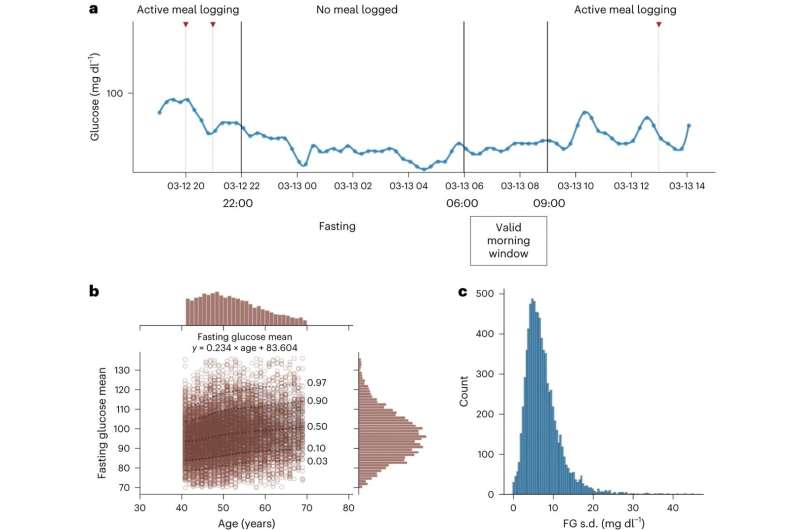April 17, 2024 report
This article has been reviewed according to Science X's editorial process and policies. Editors have highlighted the following attributes while ensuring the content's credibility:
fact-checked
peer-reviewed publication
trusted source
proofread
Researchers find glucose levels of nondiabetic people vary more than thought

A medical researcher at Tel Aviv University, working with a group of computer scientists at the Weizmann Institute of Science, both in Israel, has found that fasting glucose levels in nondiabetic people vary more than previously thought. In their study, published in the journal Nature Medicine, the group studied fasting glucose levels for thousands of nondiabetic volunteers who wore continuous glucose monitoring devices.
Currently, people are diagnosed with diabetes or prediabetes via lab reports—patients give blood, which is processed in two ways: testing blood for glycated hemoglobin levels and for elevated plasma fasting glucose (FG) levels. While the second test can be done more easily using test strips and a portable testing device, it is also used more often in assessing whether a patient needs medication to stabilize glucose levels in the blood.
But, as the researchers note, such diagnostics are done using very few blood samples, which may provide doctors with an incomplete picture of true FG levels in patients. That could lead to misdiagnoses in patients. To find out if this might be the case, the research team recruited 8,315 nondiabetic volunteers who wore continuous glucose monitoring (CGM) devices.
A CGM is an adhesive patch applied to the skin that sends signals wirelessly to a smartphone. Participants fasted for a minimum of eight hours prior to a 6 a.m. to 9 a.m. comparison window every day of the study.
The study covered 59,569 of these morning windows, and the researchers found the average level was 96.2 ± 12.87 mg dl−1 and that the group had a standard deviation of 7.52 ± 4.31 mg dl−1. They also found considerable variability in FG levels in the same people, which suggests that relying on just one or two blood tests gives incomplete results, meaning that using CGM devices to diagnose type II diabetes may provide better results.
The research team also noted that fasting duration appeared to have little correlation to FG levels or associations with other clinical measures, which they suggest hints at the possibility that FG levels may be impacted by other, still unknown, body processes.
More information: Smadar Shilo et al, Continuous glucose monitoring and intrapersonal variability in fasting glucose, Nature Medicine (2024). DOI: 10.1038/s41591-024-02908-9
© 2024 Science X Network




















